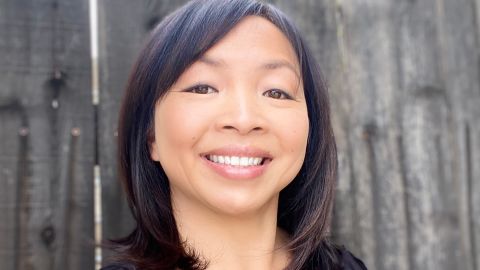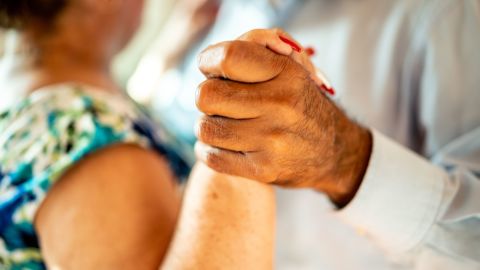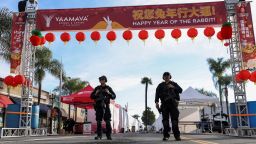Editor’s Note: Lynda Lin Grigsby is a journalist and editor who has written for NBC News, Shondaland, Parents magazine and Romper. She is a former editor of the Pacific Citizen, a national Asian American newspaper. The views expressed here are her own. Read more opinion at CNN.
A dance floor has equalizing power. When the music starts, differences fall away. On the dance floor, it doesn’t matter if you’re rich or poor. No one judges where you came from or what language you speak. What matters is how you dip your partner when the song is over.
The egalitarian nature of ballroom dance is why many older Asian American immigrants use it to practice their social and physical fitness. As dancers move, everyday problems roll off elegantly gesturing fingers and pointed toes.

Thu Luu, a competitive ballroom dancer and teacher who owns the Ballroom & Country Dance Studio in Calgary, Alberta, explained to me that, as recreational pastimes go, ballroom dancing is not too expensive, and it’s a great way to work through tough emotions.
But there is something he can’t seem to shake — the identity of the gunman, who on the eve of Lunar New Year, fatally shot 11 people, and wounded nine others in a Monterey Park, California, dance hall.
Luu didn’t know the gunman, but he recognized a connection: They were both refugees who escaped war-torn Vietnam. In 1980, Luu arrived in Canada and rebuilt his life by working as a welder. He learned a new language and customs. At night, ballroom dancing was an entry point to his adopted homeland because when words failed, he could communicate through movement.
While we talked, Luu, 63, apologized often for his halting English but quickly added, “I am well-educated in dance.”
In many ways, I am connected to Luu and the Monterey Park tragedy, too. I can recognize the struggle. I witnessed my Vietnamese refugee parents battle to establish a toehold in American life without easy access to a supportive community or resources.
Long after the war in their home country ended, they continued to live in survival mode in the margins of American society, in part, because the luxuries I enjoy by birthright as a second-generation Asian American — freedom, education, language access — are all things for which they had to fight.
Now in their 70s, my parents have found time and space for recreation. They do exercise and other rigorous movement with friends. They don’t work out on a dance floor, but the intent is the same — it’s an opportunity to move their bodies with a diverse community of older adults, free from judgment. In this place, I see my parents laugh, with eyes twinkling gleefully.

I recognized the expressions of joy when I used to walk from my old studio apartment in downtown Alhambra, California, by Lai Lai Ballroom & Studio, site of the second Lunar New Year Eve incident by the gunman. The same armed man who opened fire in Monterey Park showed up there — presumably looking once again to inflict violence on older immigrants like himself. Fortunately it was the end of the evening, and the ballroom was almost empty. An attendant, Brandan Tsay, was able to wrest away his firearm, in the process possibly saving many lives had the shooter headed to yet another dance venue.
During my walks, clusters of older adults would sometimes burst out the doors glistening with sweat and sequins, but mostly I just heard the cadence of ballroom music wafting through the air to remind me that these are sacred places for older Asian Americans in the golden days of their lives to find joy and release from daily pressure.
Ballroom dance attracts a mature crowd — about 55 years and older, said Bailey Morgan-Whitfield, studio manager and dance instructor at the Fred Astaire Dance Studios in Arcadia, California. Morgan-Whitfield told me that most of the clientele at her studio consists of older Asian Americans, who keep coming, she thinks, because the community is craving social interaction. This is especially true after the isolation of the pandemic and the anxiety stoked by spikes in anti-Asian hate.
In Asian immigrant communities, dance is a great escape, and it has roots in American history. In the 1920s and 30s, taxi dance halls were dance spaces that allowed young Filipino men employed as farmworkers to cut a rug in their limited leisure time. There was little else they could do — laws at the time limited the number of Filipinas in the United States, prohibited interracial marriage and even prevented Asian American land ownership.
For disenfranchised communities, dance can be subversive and revolutionary. It can represent an act of joyful rebellion that exists today on the ballroom dance floor.
Millie Cao has danced through war, a global pandemic, and now, a mass shooting that took her friend’s life. Her formal training in ballroom dance alongside her husband and dance partner started 10 years ago when she was in her 50s, a journey documented in the 2019 Oscar-nominated short documentary “Walk, Run, Cha-Cha.”
But even before then, Cao had always loved to dance. In the Vietnam of her youth, she would sneak off to dance parties to forget about the war. “Dance gives you a sense of freedom, a release from reality,” Cao said.

That’s part of the appeal of ballroom dancing. Its joyfulness and its accessibility attract a diverse group of Asian Americans who want to rumba away their worries. At Lai Lai Ballroom & Studio, according to Cao, the students come from China, Taiwan, Vietnam and many other countries. Her longtime dance teacher, Maksym Kapitanchuk, is from Ukraine. The cultural and language diversity is no problem because “we speak the same language of dance,” Cao said.
For years, she danced at Lai Lai Ballroom & Studio almost daily with her friend, Mymy Nhan, one of the victims of the shooting at the Star Ballroom Dance Studio.
Cao’s voice trembles when she talks about her friend. Everyone in the dance community is still in shock. Nhan was ever-present on the dance floor. “I don’t know how it will be like when I go back,” Cao said.
Get our free weekly newsletter
- Sign up for CNN Opinion’s newsletter.
- Join us on Twitter and Facebook
Not long after the fatal shooting, at a candlelight vigil in front of the Star Ballroom Dance Studio, dancers tearfully hugged each other in front of a line of pictures of the victims. Their grief was so fresh it was difficult to see. I had to close my eyes. In the darkness and quiet of our grief after a tragedy like this, how do we return to ourselves? Maybe it’s best, as poet Ocean Vuong says, to “fold the page so it points to the good part.”
The best version of this community shattered by gun violence is dancing — it has always been. Their bodies in motion are symbols of joyful rebellion and resilience. Cao said she will dance again. They all must get back on the dance floor.
They dance to forget, but also to remember.
"asian" - Google News
January 30, 2023 at 03:24AM
https://ift.tt/Wo6sxif
Opinion: Ballroom dancing remains a refuge for Asian immigrants - CNN
"asian" - Google News
https://ift.tt/z6kjoVW
Shoes Man Tutorial
Pos News Update
Meme Update
Korean Entertainment News
Japan News Update



No comments:
Post a Comment